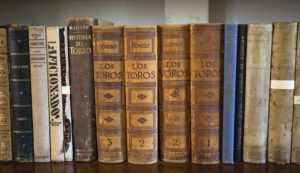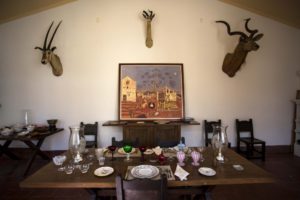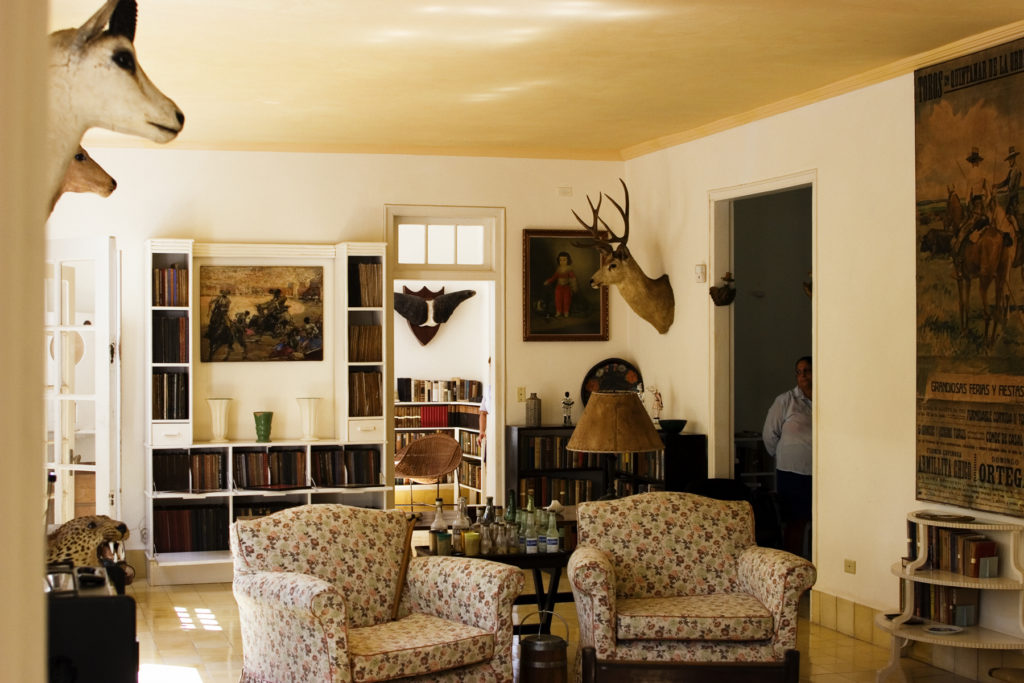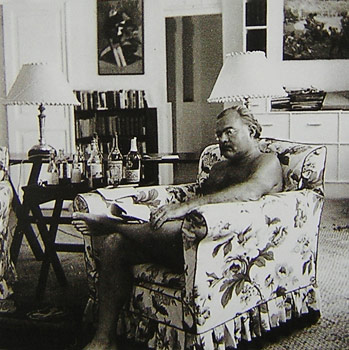A construction crew from Detroit did something last week that might have been hard to imagine in a different era: board a plane to meet a team of Cuban architects and engineers outside Havana. They gathered at a hillside home that overlooks the capital city, and worked together on a project to protect literary artifacts and the personal belongings of a famous American writer.
The estate that belonged to Ernest Hemingway is affectionately called Finca Vigía — the lookout farm. He lived there for two decades and penned some of his most famous works at the typewriter that still sits on a desk in his study.
“It’s rustic,” says Mary-Jo Adams, who leads the U.S.-based Finca Vigía Foundation, the group heading up the preservation project. “It’s just a low, seven-room bungalow. Yet it’s filled with everything the author collected.”
Hemingway was a prolific collector. Trophies from hunting trips to Africa hang on the walls: an impala, a water buffalo, a kudu’s twisted horns. Thousands of books are scattered about the house. The author’s beloved 38-foot fishing boat, Pilar, is still resting on dry ground in the backyard.
Finca Vigía appears stuck in time, and that’s part of its appeal.”The house is as he left it,” Adams says. “It’s as though he’s just gone for a swim in the pool and is ready to come back.”
Hemingway left the country for the last time in 1960, soon after Fidel Castro’s revolution upended political order in the Caribbean and around the world. About a year later, in the summer of 1961, the Nobel Prize-winning author killed himself in Ketchum, Idaho.
After his death, Hemingway’s widow enlisted the help of Jacqueline Kennedy to bring some of his papers back to the United States. The first lady had “a great respect for the arts, culture and for Ernest Hemingway,” Adams says.
“That an American guy came to Cuba, decided to live in Cuba and felt like a Cuban in that difficult moment Cubans were living, it felt like a gift. But most of his belongings never made it back. The Cuban government took control of the house and turned it into a museum (Tourist Attraction), and the following decades were hard on the building. In 2005, the National Trust for Historic Preservation called the home one of America’s most endangered historic places.
“I first went there as a termite expert,” Bob Vila, the famous Cuban American TV home renovation guru who also serves on the Finca Vigía Foundation’s board, said in a phone interview. “All the windows had rotted out, and they were making new wooden casement windows on-site.”
That first trip was in the early 2000s. With help from the Cuban government, the foundation started making renovations to the home. They also began a project to preserve the manuscripts, letters and photographs on-site. They got permission to bring U.S. tools and materials to the island, and just last week the team from Detroit was there to work with Cuban architects and engineers on a sealed vault to keep the documents preserved for generations.
The spirit of cooperation between experts from two estranged countries is “a credit to Ernest Hemingway,” Adams says. “I wonder what he would think.”
Today, there is little doubt how Cubans feel about the American. In Old Havana, tourists still pack the hotel where he stayed and the El Floridita bar where Hemingway downed up to a dozen daiquiris in a single sitting. “Hemingway opened the gates to this huge house to all the kids,” he says. “That an American guy came to Cuba, decided to live in Cuba and felt like a Cuban in that difficult moment Cubans were living, it felt like a gift.”
LA PRESERVACIÓN DE PERTENENCIAS DE ERNEST HEMINGWAY: OBJETIVO DE ESTADOS UNIDOS Y CUBA.
Un equipo de construcción de Detroit hizo algo la semana pasada que podría haber sido difícil de imaginar en una era diferente: abordar un avión para conocer a un equipo de arquitectos e ingenieros cubanos fuera de La Habana. Se reunieron en una casa en la ladera que domina la ciudad capital, y trabajaron juntos en un proyecto para proteger los objetos literarios y las pertenencias personales de un famoso escritor estadounidense.
La finca que perteneció a Ernest Hemingway se llama cariñosamente Finca Vigía, la granja de vigilancia. Vivió allí durante dos décadas y escribió algunas de sus obras más famosas en la máquina de escribir que aún se sienta en un escritorio de su estudio.
“Es rústico”, dice Mary-Jo Adams, quien dirige la Fundación Finca Vigía, con sede en los Estados Unidos, el grupo que encabeza el proyecto de preservación. “Es solo un bungalow bajo de siete habitaciones. Sin embargo, está lleno de todo lo que el autor recopiló”.
Hemingway fue un coleccionista prolífico. Trofeos de viajes de caza a África cuelgan en las paredes: un impala, un búfalo de agua, cuernos retorcidos de un kudu. Miles de libros están dispersos por la casa. El barco de pesca de 38 pies de altura del autor, Pilar, todavía descansa en un terreno seco en el patio trasero.
Finca Vigía parece atrapada en el tiempo, y eso es parte de su atractivo: “La casa es como la dejó”, dice Adams. “Es como si acabara de darse un baño en la piscina y estuviera listo para regresar”.
Hemingway abandonó el país por última vez en 1960, poco después de que la revolución de Fidel Castro volcó el orden político en el Caribe y en todo el mundo. Alrededor de un año después, en el verano de 1961, el autor ganador del Premio Nobel se suicidó en Ketchum, Idaho.
Después de su muerte, la viuda de Hemingway solicitó la ayuda de Jacqueline Kennedy para traer algunos de sus papeles a los Estados Unidos. La primera dama tuvo “un gran respeto por las artes, la cultura y por Ernest Hemingway”, dice Adams.
“Que un tipo americano vino a Cuba, decidió vivir en Cuba y se sintió como un cubano en el momento difícil en que vivían los cubanos, se sintió como un regalo. Pero la mayoría de sus pertenencias nunca regresaron. El gobierno cubano tomó el control del país. casa y lo convirtió en un museo (atracción turística), y las siguientes décadas fueron duras en el edificio. En 2005, el National Trust for Historic Preservation llamó al hogar uno de los lugares históricos más amenazados de América.
“Fui por primera vez como un experto en termitas”, dijo en una entrevista telefónica Bob Vila, el famoso gurú de la renovación de la televisión cubanoamericana que también trabaja en la junta directiva de la Fundación Finca Vigía. “Todas las ventanas se habían podrido y estaban haciendo nuevas ventanas de madera en el sitio”.
Ese primer viaje fue a principios de la década de 2000. Con la ayuda del gobierno cubano, la fundación comenzó a realizar renovaciones en el hogar. También comenzaron un proyecto para preservar los manuscritos, cartas y fotografías en el sitio. Obtuvieron permiso para traer herramientas y materiales de EE. UU. A la isla, y la semana pasada el equipo de Detroit estuvo allí para trabajar con arquitectos e ingenieros cubanos en una bóveda sellada para mantener los documentos preservados durante generaciones.

EH 6667P
Ernest Hemingway at his home, Finca Vigia, in Cuba. Please credit “Ernest Hemingway Collection/John F. Kennedy Presidential Library and Museum, Boston”
El espíritu de cooperación entre expertos de dos países distanciados es “un crédito para Ernest Hemingway”, dice Adams. “Me pregunto qué pensaría él”.
Hoy, hay pocas dudas de cómo se sienten los cubanos sobre el estadounidense. En la Habana Vieja, los turistas aún empaquetan el hotel donde se hospedó y el bar El Floridita donde Hemingway derribó hasta una docena de daiquiris en una sola sesión. “Hemingway abrió las puertas de esta gran casa para todos los niños”, dice. “Que un tipo americano vino a Cuba, decidió vivir en Cuba y se sintió como un cubano en el momento difícil en que vivían los cubanos, se sintió agraciado”.
Agencies/Here and Now/Peter O’Dowd/Excerpts/Internet Photos/ Arnoldo Varona/ TheCubanHistory.com
THE CUBAN HISTORY, HOLLYWOOD.










